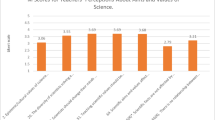Abstract
Understanding how alternative conceptions are formed can make it easier for classroom teachers to help their students uncover their own alternative conceptions. Teachers, however, cannot be expected to help children with alternative conceptions if they hold these alternative conceptions themselves. A questionnaire containing common earth/space science alternative conceptions was administered to 122 preservice elementary teachers. A discussion of alternative conceptions followed during which participants were asked to reflect on their responses. The study suggests that many misconceptions originate in the classroom and that pre-service elementary education teachers have many of the same misconceptions that their future students will have.
Similar content being viewed by others
References
Anderson, C. W., & Smith, E. L. (1987). Teaching science. In V. Richardson-Koehler (Ed.)Educator's Handbook: A research perspective. New York: Longman.
Ault, C. R., Jr. (1982). Time in geological explanations as perceived by elementary school students.Journal of Geological Education, 30, 304–309.
Ault, C. R., Jr. (1984a). The everyday perspective and exceedingly unobvious meaning.Journal of Geological Education, 32, 89–91.
Ault, C. R., Jr. (1984b). Intelligently wrong: Some comments on children's misconceptions.Science and Children, 21(8), 22–24.
Bar, V. (1989). Children's views about the water cycle.Science Education, 73, 481–500.
Berg, T., & Brouwer, W. (1991). Teacher awareness of student alternative conceptions about rotational motion and gravity.Journal of Research in Science Teaching, 28, 3–18.
Cohen, M. R., & Kagen, M. H. (1979). Where does the old moon go?The Science Teacher, 46(8), 22–23.
Doran, R. L. (1972). Misconceptions of selected science concepts held by elementary school students.Journal of Research in Science Teaching, 9, 127–137.
Driver, R. (1991). Culture clash: children and science.New Scientist, June 29, 46–48.
Driver, R., & Easley, J. (1978). Pupils and paradigms: A review of literature related to concept development in adolescent science students.Studies in Science Education, 5, 61–84.
Fisher, K. M. (1983) In H. Helm, & J. D. Novak (Chairs)Proceedings of the International Seminar on Misconceptions in Science and Mathematics, Ithaca, NY: Cornell University.
Fisher, K. M., & Lipson, J. (1986). Twenty questions about student errors.Journal of Research in Science Teaching, 23, 783–803.
Gilman, D., Hernandez, I., & Cripe, R. (1970). The correction of general science misconceptions as a result of feedback mode in computer-assisted instruction.Proceedings of the National Association for Research in Science Teaching. Minneapolis.
Griffith, B. E., & Benson, G. D. (1991).Novice Teachers' Ways of Knowing, Paper presented at the Annual Meeting of the American Educational Research Association: Chicago.
Harvard-Smithsonian Center for Astrophysics. (1985).A Private Universe. a video-documentary.
Hewson, P. W. (1981). Aristotle: Alive and well in the classroom?The Australian Science Teachers Journal, 27, 9–13.
Hewson, P. W. (1985). Diagnosis and remediation of an alternative conception of velocity using a microcomputer program.American Journal of Physics, 53, 684–690.
Hewson, M. G., & Hewson, P. W. (1983). Effect of instruction using students' prior knowledge and conceptual change strategies on science learning.Journal of Research in Science Teaching, 20, 731–743.
Keig, P. F. (1991).Student misapplications of terms: Evidence of elements of concept formation and a proposed category system of concept formation error types. Paper presented at the Annual meeting of the American Educational Research Association: Chicago.
Kimble, G. H. (1955).Our American weather. New York: McGraw-Hill.
Kuethe, L. J. (1963). Science concepts: A study of sophisticated errors.Science Education, 47, 361–364.
Lightman, A. P., Miller, J. D., & Leadbeater, B. J. (1987). Contemporary cosmological beliefs.Proceedings of the Second International Seminar on Misconceptions and Educational Strategies in Science and Mathematics (pp. 309–321). Ithaca, NY: Cornell University.
Marek, E. A., & Methven, S. B. (1991). Effects of the learning cycle upon student and classroom teacher performance.Journal of Research in Science Teaching, 28, 41–53.
Meyer, W. B. (1987). Vernacular American theories of earth science.Journal of Geological Education, 35, 193–196.
Muthukrishna, N., Carnine, D., Grossen, B., & Miller, S. (1993). Children's alternative frameworks: Should they be directly addressed in science instruction?.Journal of Research in Science Teaching, 30, 233–248.
Novak, J. D. (1990). Concept mapping: A useful tool for science education.Journal of Research in Science Teaching, 27, 937–949.
Nussbaum, J. (1979). Children's conceptions of the earth as a cosmic body: A Cross Age study.Science Education, 63, 83–93.
Nussbaum, J., & Novick, S. (1982). Alternative frameworks, conceptual conflict and accommodation: toward a principled teaching strategy.Instructional Science, 11, 183–200.
Osborne, R. J., Bell, B. F., & Gilbert, J. K. (1983). Science teaching and children's views of the world.European Journal of Science Education, 5, 1–14.
Posner, G. J., Strike, K. A., Hewson, P. W., & Gertzog, W. A. (1982). Accommodation of a scientific conception: Toward a theory of conceptual change.Science Education, 66, 221–227.
Riekehof, L. L. (1963).Talk to the deaf. Springfield, Mo, Gospel Publishing House.
Sadler, P. M. (1987). Misconceptions in astronomy.Proceedings of the Second International Seminar on Misconceptions and Educational Strategies in Science and Mathematics (pp. 422–425). Ithaca, NY: Cornell University.
Schoon, K. J. (1992). Students' alternative conceptions of earth and space.Journal of Geological Education, 40, 209–214.
Wandersee, J. H. (1985). Can the history of science help science educators anticipate students' misconceptions?Journal of Research in Science Teaching, 23, 581–597.
Zietsman, A. I., & Hewson, P. W., (1986). Effect of instruction using microcomputer simulations and conceptual change strategies on science learning.Journal of Research in Science Teaching, 23, 27–39.
Author information
Authors and Affiliations
Rights and permissions
About this article
Cite this article
Schoon, K.J. The origin and extent of alternative conceptions in the earth and space sciences: A survey of pre-service elementary teachers. J Elem Sci Edu 7, 27–46 (1995). https://doi.org/10.1007/BF03173734
Issue Date:
DOI: https://doi.org/10.1007/BF03173734




